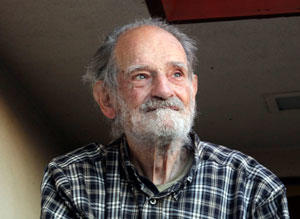Tiger of the Week: Lloyd Shapley *53
Lloyd Shapley *53 (Photo: AP Photo/Reed Saxon)
In the fall of 1949, two young mathematicians interested in game theory lived on the same floor of the Graduate College and became friendly rivals — John Nash *50, who won the Nobel Prize in 1994 and became famous as the subject of the book and film A Beautiful Mind, and Lloyd Shapley *53, who was awarded the Nobel prize on Oct. 15.
Shapley, who is 89, won the Nobel in economics sciences with Alvin Roth, a professor at Harvard, for their work on the design of markets and matching theory. Working independently of one another, the two addressed the problem of how to match different agents in a market as efficiently as possible — pairing new doctors with hospitals, prospective students with schools, or patients needing organ transplants with donors. Shapley’s work, which applies to markets where price is not a factor, seeks to ensure that both sides feel they have gotten the most attractive match. Shapley established the theoretical underpinnings of the theories in the 1950s and 1960s, while Roth devised real-world applications.
“Shapley is on a short list of the most important figures in game theory, many of whom were at Princeton at more or less the same time,” including Nash, David Gale *49, and Harold Kuhn *50, said Princeton economics professor Dilip Abreu. “They were huge talents, all present at the birth of the field, and that combination was quite explosive.”
Shapley earned a Ph.D. in mathematics in 1953 and taught at Princeton for three years before becoming a research mathematician at the RAND Corporation. He currently is a professor emeritus of economics and mathematics at UCLA, where he joined the faculty in 1981.
Sixty-three years ago, when Shapley and Nash were hotshots in Princeton’s math department, they frequently sat together in Fine Hall thrashing out ideas about game theory. Kuhn, who now is a professor emeritus in the Princeton mathematics department, said Nash and Shapley were “very much friendly rivals” who enjoyed tossing ideas back and forth or playing Go, a strategy-intensive board game played in China for thousands of years.
“The common room at Fine Hall was the place where everyone met every afternoon, and the ideas sort of bubbled over there,” Kuhn said. “Lloyd Shapley was the best in terms of his overall accomplishments of a very bright group of people. His Nobel is long overdue.”
Do you have a nominee for Tiger of the Week? Let us know. All alumni qualify. PAW's Tiger of the Week is selected by our staff, with help from readers like you.













No responses yet